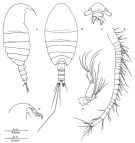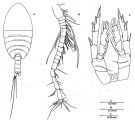|
|
 |
|
Calanoida ( Order ) |
|
|
|
Epacteriscoidea ( Superfamily ) |
|
|
|
Epacteriscidae ( Family ) |
|
|
|
Epacteriscus ( Genus ) |
|
|
| |
Epacteriscus rapax Fosshagen, 1973 (F,M) | |
| | | | | | | Ref.: | | | Fosshagen, 1973 (p.146, figs.F,M); Huys & Boxshall, 1991 (p.52, 70, 80, figs.F); Fosshagen & al., 2001 (p.276, 316, Rem.); Boxshall & Halsey, 2004 (p.113: figs.F) |  issued from : A. Fosshagen in Sarsia, 1973, 52. [p.148, Fig.1]. Female (from N of Key Largo, Florida): A, habitus (lateral right side); B, idem (dorsal); C, forehead with rostrum, labrum and distal part of mandibular blade (ventral view); D, idem (lateral right side); E, A1; F, A2. Nota: Rostrum broad, consists of 2 rounded, down-turned plates with a cleft in between, each plate with 1 filament. A1 24-segmented ( well furnished with setae and aesthetascs), extending backwards to the last segment of the prosome. Exopod of A2 5-segmented, endopod 2-segmented. Urosome 3-segmented. Genital segment with genital openings set close together. Furcal rami with 5 plumose setae (the outermost small), both 2nd and 3rd setae jointed near their bases.
|
 issued from : A. Fosshagen in Sarsia, 1973, 52. [p.149, Fig.2]. Female: A, Md; B, Mx1; C, Mx2; D, Mxp; E, P1; F, P2; G, P3; H, P4; I, P5. Nota: Mx1 has few setae and weakly developed lobes: 1st lobe with 4 small setae, and the outer one 3 long setae; the terminal part (exopod?) with 4 long setae. Mx2: 1st segment bears a small lobe with 3 setae, 1 single seta, 3 setae in a group, and finally 2 large setae close together; the rest of the limb with at its tip several spinous setae. Md unique among calanoids; palp small, exopod with 4 setae, no endopod; the cutting blade has a prominent extension bearing sharp teeth, this serrated process extends out from the body and seems to serve as one arm of a pair of forceps for catching prey. Closer to the body on the cutting blade itself there are 2 sharp teeth and a broad toothed process (which resemble the usual type of cutting edge of a calanoid, and which probably function in the same way). The following pecularities distinguish the endopods of P2-P4 from those of other calanoids: the outer margin of the 1st segment bears a pointed process in its middle; the two setae along the outer margin of the last segment are each inserted in a deep indentation; distally to both the process and the two setae the margin is finely serrated; the outer margin of the basipod of P4 and P5 bears a long seta.
|
 issued from : A. Fosshagen in Sarsia, 1973, 52. [p.151, Fig.3]. Male: A, habitus (dorsal); B, right A1; C, P5 (posterior view). Nota: Right A1 17-segmented, geniculation between segments 13 and 14. Except A1, the other cephalic appendages and the first four legs cannot be distinguished from those of the female.
| | | | | NZ: | 1 | | |
|
Distribution map of Epacteriscus rapax by geographical zones
|
| | | | Loc: | | | Florida (Broad Creek), Bermuda (Cherry Pit cave), Colombia (Punta de Betin) | | | | N: | 2 | | | | Lg.: | | | (383) F: 0,74; 0,73; M: 0,63; {F: 0,73-0,74; M: 0,63} | | | | Rem.: | epibenthic (depth: 1-4 m), among corals.
The gnathobase of the Md shows an original form.
For Fosshagen (1973, p.151) the aberrant mouthparts prevent to assign the species to any existing family, though it may be placed within the Centropagina. Resemblances to existing families do occur, but whether these are the result of a similar way of life or indicate phylogenetic relationships remains uncertain. A mandibular palp without an endopod and a reduced Mx1 is also found in the Arietellidae (Scottula, Paramisophria). Arietellids, however, show more reduction in P5 in both sexes, have an asymmetrical A1 in female, and a geniculation on the left side in the male.
Some reduction of the endopods of A2 and Md is present in the Ridgewayiidae (Exumella). Primitive legs with 3-segmented rami, a geniculation on the male right A1, with genital openings set close together on the genital segment are also reminiscent of this family, but the characteristic modifications to the P5 of the females in the Ridgewayiidae is absent in Epacteriscus
.
A large curved process on the mandibular blade is present on the right Md in Heteroptilus (Augaptilidae) (See in Sars, 1924, fig.116 (6) and 1925, p.325), other characters do not suggest a close relationship. | | | Last update : 03/01/2015 | |
|
|
 Any use of this site for a publication will be mentioned with the following reference : Any use of this site for a publication will be mentioned with the following reference :
Razouls C., Desreumaux N., Kouwenberg J. and de Bovée F., 2005-2025. - Biodiversity of Marine Planktonic Copepods (morphology, geographical distribution and biological data). Sorbonne University, CNRS. Available at http://copepodes.obs-banyuls.fr/en [Accessed August 26, 2025] © copyright 2005-2025 Sorbonne University, CNRS
|
|
 |
 |






